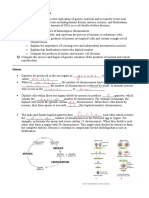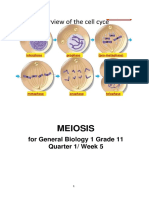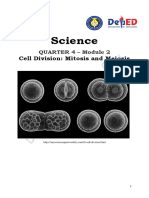0 ratings0% found this document useful (0 votes)
35 viewsLecture - Meiosis - Student Version
Lecture - Meiosis - Student Version
Uploaded by
Samuel BuakuMeiosis produces gametes with half the normal number of chromosomes through two nuclear divisions. During meiosis, homologous chromosomes pair and may exchange genetic material through crossing over, and separate randomly into gametes, resulting in genetic variation between offspring. Meiosis is essential for sexual reproduction as it restores the diploid number when gametes fuse during fertilization.
Copyright:
© All Rights Reserved
Available Formats
Download as PPTX, PDF, TXT or read online from Scribd
Lecture - Meiosis - Student Version
Lecture - Meiosis - Student Version
Uploaded by
Samuel Buaku0 ratings0% found this document useful (0 votes)
35 views18 pagesMeiosis produces gametes with half the normal number of chromosomes through two nuclear divisions. During meiosis, homologous chromosomes pair and may exchange genetic material through crossing over, and separate randomly into gametes, resulting in genetic variation between offspring. Meiosis is essential for sexual reproduction as it restores the diploid number when gametes fuse during fertilization.
Original Title
Lecture - Meiosis - Student version (2)
Copyright
© © All Rights Reserved
Available Formats
PPTX, PDF, TXT or read online from Scribd
Share this document
Did you find this document useful?
Is this content inappropriate?
Meiosis produces gametes with half the normal number of chromosomes through two nuclear divisions. During meiosis, homologous chromosomes pair and may exchange genetic material through crossing over, and separate randomly into gametes, resulting in genetic variation between offspring. Meiosis is essential for sexual reproduction as it restores the diploid number when gametes fuse during fertilization.
Copyright:
© All Rights Reserved
Available Formats
Download as PPTX, PDF, TXT or read online from Scribd
Download as pptx, pdf, or txt
0 ratings0% found this document useful (0 votes)
35 views18 pagesLecture - Meiosis - Student Version
Lecture - Meiosis - Student Version
Uploaded by
Samuel BuakuMeiosis produces gametes with half the normal number of chromosomes through two nuclear divisions. During meiosis, homologous chromosomes pair and may exchange genetic material through crossing over, and separate randomly into gametes, resulting in genetic variation between offspring. Meiosis is essential for sexual reproduction as it restores the diploid number when gametes fuse during fertilization.
Copyright:
© All Rights Reserved
Available Formats
Download as PPTX, PDF, TXT or read online from Scribd
Download as pptx, pdf, or txt
You are on page 1of 18
Meiosis
Produces four daughter nuclei each with half the number of
chromosomes of the parent. The daughter cells are
genetically different.
By the end of this lecture you should be able to:
• describe with the aid of diagrams, the processes involved in meiotic
cell division;
• discuss how meiosis contributes to heritable variation;
• explain why sexually produced organisms vary in characteristics;
The principles behind meiosis
• Each of the cells of an adult of a species has a fixed number of
chromosomes, usually made up of pairs that control the same
characteristics.
• One of each pair is derived from the chromosomes provided in the egg by
the mother (maternal chromosomes) and the other of each pair is
derived from the chromosomes provided in the sperm by the father
(paternal chromosomes). These are known as homologous pairs and the
total number is referred to as the diploid number (2n); in humans this is
46.
• During meiosis each of the pairs are separated, so that only one enters
each sex cell or gamete. This is known as the haploid number (n) and in
humans is 23.
• When two haploid gametes fuse, the diploid number of chromosomes is
restored. The new cell formed is called a zygote and this then divides by
mitosis to maintain the diploid number in all further cells.
Chromosomes of a diploid cell
A karyotype is the number and appearance of chromosomes in the nucleus of a
eukaryotic cell.
Describe each of the three karyotypes below.
The stages of meiosis
The stages of meiosis
Questions
1. During which division, meiosis I or meiosis II, is the chromosome number
halved?
2. Which of these divisions would be possible? Explain your answers.
a) A diploid cell dividing by mitosis to form diploid cells
b) A diploid cell dividing by meiosis to form haploid cells
c) A haploid cell dividing by mitosis to form haploid cells
d) A haploid cell dividing by meiosis to form haploid cells
3. Name the stage of meiosis at which each of these events occurs. Remember
to state whether the stage is in meiosis I or meiosis II.
a) Homologous chromosomes pair to form bivalents.
b) Chiasmata form between chromatids of homologous chromosomes.
c) Homologous chromosomes separate.
d) Centromeres divide and chromatids separate.
e) Haploid nuclei are first formed.
How meiosis causes variation
• Independent assortment: during meiosis, the pairs of homologous
chromosome are divided in half to form haploid cells, and this
separation, or assortment, of homologous chromosomes is random.
This means that all of the maternal or paternal chromosomes will not
be separated into one cell.
• Crossing over: the exchange of alleles between chromatids of
homologous chromosomes as a result of chiasma formation during
prophase of meiosis I.
Other source of variation
• Random fertilisation: Any male gamete could fuse with any female
gamete.
Independent assortment
Independent assortment
Crossing over
Crossing over
Comparison of mitosis and meiosis
Questions
1. Which of the following statements is true of homologous
chromosomes?
a. During prophase of mitosis each chromosome is made up of two
identical structures called chromatids.
b. Homologous chromosomes move to the same pole during nuclear
division.
c. Homologous chromosomes have the same sequence of base pairing in
their DNA structure.
d. Only diploid cells contain homologous chromosomes.
2. Which of the following processes does not involve variation?
a. Independent assortment at metaphase
b. Structural changes on chromosomes as a result of mutations
c. The pairing of Y and X chromosomes
d. Chiasmata formation in prophase
3. Which of the following activities is not associated with metaphase 1 of
meiosis?
a. The bivalents move to the equatorial plate across the centre of the cell.
b. The paternal and maternal chromosomes in each bivalent position
themselves independently of the others.
c. The chromosomes are pulled towards the poles by the shortening of
the microtubules.
d. The microtubules attach to the centromere of each chromosome.
4. Which of the following is not a significance of meiosis?
a. The production of haploid gametes
b. Creation of genetic variety by random distribution of chromosomes
during metaphase 1
c. Creation of genetic variety by crossing over between homologous
chromosomes
d. Creation of a genetic variety by keeping the chromosome numbers the
same
5. Meiosis contributes to the heritable variation by which of the activities?
i. Crossing over ii. Independent assortment iii. Interphase iv. Cytokinesis
a. i and iv b. i and ii c. ii and iii d. i and iii
You might also like
- Genetics A Conceptual Approach 6th Edition by Pierce ISBN Solution ManualDocument5 pagesGenetics A Conceptual Approach 6th Edition by Pierce ISBN Solution Manualrose100% (37)
- POGIL - MeiosisDocument4 pagesPOGIL - MeiosisKajal Vaghasia0% (1)
- PharmacologyDocument271 pagesPharmacologysweta suman100% (4)
- GeneticDocument34 pagesGeneticDark_KiroNo ratings yet
- Cell Division A Level.Document14 pagesCell Division A Level.AJ Sagg. Cann.No ratings yet
- Meiosis and Practice QuestionDocument8 pagesMeiosis and Practice Questionfekade.0935No ratings yet
- Mitosis and Meiosis Study Guide KEYDocument8 pagesMitosis and Meiosis Study Guide KEYrodneyperuNo ratings yet
- 6.3 MeiosisDocument24 pages6.3 MeiosisPratika MNo ratings yet
- MeiosisDocument7 pagesMeiosistaym.abdulhakNo ratings yet
- Meiosis Notes 2018 Fill InsDocument19 pagesMeiosis Notes 2018 Fill InsLydia LamNo ratings yet
- q1 Genbio1 Slkweek5 v2 EditDocument9 pagesq1 Genbio1 Slkweek5 v2 EditInele Ellia AgReNo ratings yet
- Meiosis ReadingDocument5 pagesMeiosis Readingapi-262368188No ratings yet
- Cell Division: Better Your DreamsDocument11 pagesCell Division: Better Your DreamsDouglas MusinguziNo ratings yet
- CA Lesson 2 Meiosis+and+Sexual+ReproductionDocument38 pagesCA Lesson 2 Meiosis+and+Sexual+ReproductionNKANo ratings yet
- Lesson Notes: Biology 4G Chapter 5: Cell DivisionDocument17 pagesLesson Notes: Biology 4G Chapter 5: Cell DivisionBenjamin TeeNo ratings yet
- Biosc 150 Exam 4 Study Guide: Chapter 13: MeiosisDocument23 pagesBiosc 150 Exam 4 Study Guide: Chapter 13: MeiosisKhusbu PatelNo ratings yet
- Science8 Q4 M2Document6 pagesScience8 Q4 M2Arabella BaldonadoNo ratings yet
- Genetics Continuation 093202Document9 pagesGenetics Continuation 093202nkondeprince77No ratings yet
- Pre-Final Activity 4-For StudentsDocument8 pagesPre-Final Activity 4-For Studentsciansolomon34No ratings yet
- Reviewer Gr12 Mitosismeiosis.Document3 pagesReviewer Gr12 Mitosismeiosis.Pinky SalesNo ratings yet
- Quarter 4 Module 5Document10 pagesQuarter 4 Module 5jiyuskie09No ratings yet
- The Biology Project - Meiosis TutorialDocument8 pagesThe Biology Project - Meiosis TutorialJimmie MaddoxNo ratings yet
- Las 7Document4 pagesLas 7Elijah Dan DoinesNo ratings yet
- L3 Meiosis LessonDocument16 pagesL3 Meiosis LessonJoan Ng'ongoloNo ratings yet
- Meiosispacketanswer PDFDocument6 pagesMeiosispacketanswer PDFVictoria Afrianty BessieNo ratings yet
- Cell DivisionDocument8 pagesCell Divisionlelejfintlskia1we39No ratings yet
- MeiosisDocument56 pagesMeiosisprincess mangiNo ratings yet
- Chapter 13:meiosis and Sexual Life CyclesDocument7 pagesChapter 13:meiosis and Sexual Life Cycleskuitang100% (1)
- Cell Division Mitosis& Meiosis ModifiedDocument55 pagesCell Division Mitosis& Meiosis Modifiedmiz.pigfedNo ratings yet
- CA Lesson 2 Meiosis+and+Sexual+ReproductionDocument43 pagesCA Lesson 2 Meiosis+and+Sexual+ReproductionQbasantNo ratings yet
- Meiosis Phases After Sexual ReproductionDocument30 pagesMeiosis Phases After Sexual ReproductionJohanna UrwinNo ratings yet
- MeiosisDocument113 pagesMeiosisSubhradeep GhoshNo ratings yet
- Cell Cycle MeiosisDocument39 pagesCell Cycle MeiosisbarackobamalagranNo ratings yet
- MeiosisDocument34 pagesMeiosisJared CoyagboNo ratings yet
- Lecture 6 2018Document33 pagesLecture 6 2018Wiza MulengaNo ratings yet
- Inheritance, MeiosisDocument7 pagesInheritance, MeiosisTadi MurombaNo ratings yet
- Meiosis: Chromatids (The Two Halves of A Duplicated Chromosome), As inDocument29 pagesMeiosis: Chromatids (The Two Halves of A Duplicated Chromosome), As inyamamaNo ratings yet
- Meiosis and Sexual ReproductionDocument48 pagesMeiosis and Sexual Reproductionerdayu86100% (1)
- Lecture 2Document58 pagesLecture 2shaheenNo ratings yet
- Module 2 Meiosis and MitosisDocument88 pagesModule 2 Meiosis and MitosisSevdred CadelinaNo ratings yet
- Meiosis 2Document6 pagesMeiosis 2Areefa MohamedNo ratings yet
- Science 8 Quarter 4 Module 2 Week 2 Cell Division Let's UnderstandDocument4 pagesScience 8 Quarter 4 Module 2 Week 2 Cell Division Let's Understandabadloraine0331No ratings yet
- 4.BPVR's Revision Cell CycleDocument4 pages4.BPVR's Revision Cell CycleRam P.V.RNo ratings yet
- MeiosisDocument23 pagesMeiosistaskeen daiyanNo ratings yet
- Cell Division Class SSCDocument10 pagesCell Division Class SSCnoobradoctorNo ratings yet
- Cell Cycle and Meiosis, Overcrossing and Recombinant of MeiosisDocument30 pagesCell Cycle and Meiosis, Overcrossing and Recombinant of MeiosisChloie NonatoNo ratings yet
- Meiosis: Prophase IDocument4 pagesMeiosis: Prophase IEthan Del FierroNo ratings yet
- Meiosis and Sexual Reproduction Review SheetDocument5 pagesMeiosis and Sexual Reproduction Review SheetKen PulmonesNo ratings yet
- CBSE Quick Revision Notes (Class-11 Biology) Chapter-10 Cell Cycle and Cell DivisionDocument4 pagesCBSE Quick Revision Notes (Class-11 Biology) Chapter-10 Cell Cycle and Cell DivisionArnavNo ratings yet
- Chapter 2.7 Meiotic DivisionDocument16 pagesChapter 2.7 Meiotic DivisionRACHEL SINDHUNo ratings yet
- Biol 216 2020 Topic 1 Reproduction - PowerPoint 1.1 Mitosis Meiosis BK - TaggedDocument33 pagesBiol 216 2020 Topic 1 Reproduction - PowerPoint 1.1 Mitosis Meiosis BK - TaggedMichael HamoudiNo ratings yet
- Grade 7 - Revision SheetDocument14 pagesGrade 7 - Revision SheetRehamsalahNo ratings yet
- Metaphase I Encompasses The Alignment of Paired Chromosomes Along The CenterDocument4 pagesMetaphase I Encompasses The Alignment of Paired Chromosomes Along The CenterClaudine Cabanero CaballeroNo ratings yet
- Cell-Cycle and Cell DivisionDocument3 pagesCell-Cycle and Cell DivisionToby TrollyNo ratings yet
- Inbound 4185024769852247435Document13 pagesInbound 4185024769852247435Chesca DacilloNo ratings yet
- Module Three: Life at A Molecular, Cellular and Tissue LevelDocument35 pagesModule Three: Life at A Molecular, Cellular and Tissue LevelRoslyn TaylorNo ratings yet
- Biology 9700 Notes Topic 16 Inherited Change 2019-20Document32 pagesBiology 9700 Notes Topic 16 Inherited Change 2019-20ADEEL AHMAD67% (3)
- Florante at Laura ScriptDocument24 pagesFlorante at Laura Scriptrei33973No ratings yet
- Topical Guidebook For GCE O Level Biology 3 Part 2From EverandTopical Guidebook For GCE O Level Biology 3 Part 2Rating: 5 out of 5 stars5/5 (1)
- Natural Selection LectureDocument27 pagesNatural Selection LectureSamuel BuakuNo ratings yet
- Variation and Mutation Lecture 1Document23 pagesVariation and Mutation Lecture 1Samuel BuakuNo ratings yet
- Variation and Mutation Lecture 2Document25 pagesVariation and Mutation Lecture 2Samuel BuakuNo ratings yet
- Extraction of DNA From FruitsDocument1 pageExtraction of DNA From FruitsSamuel BuakuNo ratings yet
- Roche MidiprepDocument7 pagesRoche MidiprepBee CarbonellNo ratings yet
- Interactive Learning Activities - Chaunacie WadeDocument2 pagesInteractive Learning Activities - Chaunacie Wadeapi-480268581No ratings yet
- Bangabandhu Sheikh Mujibur Rahman Science & Technology University, GopalganjDocument12 pagesBangabandhu Sheikh Mujibur Rahman Science & Technology University, GopalganjRayhan parvej ShovonNo ratings yet
- Gerontol, Gerontolmed, GerDocument23 pagesGerontol, Gerontolmed, GerrositaNo ratings yet
- Amirol, Faharodin K - Narrative Report - Cell Structure & FunctionDocument11 pagesAmirol, Faharodin K - Narrative Report - Cell Structure & FunctionyvhoriedawsonNo ratings yet
- Nature - Drug Repositioning ReviewDocument18 pagesNature - Drug Repositioning Reviewempereur100% (1)
- EPI and HIV 1Document5 pagesEPI and HIV 1April Ivonne Claire BatoNo ratings yet
- Mini Project Report FinalDocument40 pagesMini Project Report Final【BEING MYSTIC】 (teen rider)No ratings yet
- Advances in Gladiolus BreedingDocument71 pagesAdvances in Gladiolus Breedingkanchana100% (2)
- Btac 492Document9 pagesBtac 492lbqurtftsNo ratings yet
- Genetics Revision MaterialDocument38 pagesGenetics Revision MaterialSimlindile NgobelaNo ratings yet
- Teknik Fermentasi Batch, Fed-Batch, Dan ContinueDocument8 pagesTeknik Fermentasi Batch, Fed-Batch, Dan ContinueFandy RoevNo ratings yet
- UGRD-GE6116 Science, Technology, and Society FINALS QUIZ 1Document21 pagesUGRD-GE6116 Science, Technology, and Society FINALS QUIZ 1Wawi Dela RosaNo ratings yet
- What Is BiologyDocument4 pagesWhat Is BiologyMarie Elaine B. CaparasNo ratings yet
- Agarose Gels IMBB 2013Document31 pagesAgarose Gels IMBB 2013Andrés Suazo SánchezNo ratings yet
- Cell Cycle and Cell Division Sample Paper 2Document2 pagesCell Cycle and Cell Division Sample Paper 2lavanya rajaNo ratings yet
- Phases of MitosisDocument11 pagesPhases of MitosiskxtnystromNo ratings yet
- Tissue Engineering and Regenerative MedicineDocument6 pagesTissue Engineering and Regenerative MedicineMirsad ČikarićNo ratings yet
- Eukaryotic Chromosome PresentationDocument14 pagesEukaryotic Chromosome PresentationmadatoiNo ratings yet
- IS MIDTERM-mergedDocument35 pagesIS MIDTERM-mergedGennelyn Ross Delos ReyesNo ratings yet
- Mark Scheme (Results) November 2020: Pearson Edexcel International GCSE in Biology (4BI1) Paper 2BRDocument16 pagesMark Scheme (Results) November 2020: Pearson Edexcel International GCSE in Biology (4BI1) Paper 2BRThakoon TtsNo ratings yet
- RECEPTORSDocument22 pagesRECEPTORSpharmazone4u100% (1)
- Assignment Questions - B.P.P.K - I - MidDocument11 pagesAssignment Questions - B.P.P.K - I - MidDr. B. Sree Giri PrasadNo ratings yet
- Microbiology Assignment: Microbial Diversity MollicutesDocument7 pagesMicrobiology Assignment: Microbial Diversity MollicutesVidushi GuptaNo ratings yet
- Pharmacokinetics PowerPoint PresentationDocument15 pagesPharmacokinetics PowerPoint Presentationamy100% (1)
- Microbiology 2421 Lecture Notes Microbial GeneticsDocument19 pagesMicrobiology 2421 Lecture Notes Microbial GeneticsFaye Coleen GozaNo ratings yet
- Organogenesis: A Brief AccountDocument21 pagesOrganogenesis: A Brief AccountTask BirdNo ratings yet
- (Methods in Molecular Biology) George Karlin-Neumann, Francisco Bizouarn - Digital PCR - Methods and Protocols-Humana Press (2018)Document553 pages(Methods in Molecular Biology) George Karlin-Neumann, Francisco Bizouarn - Digital PCR - Methods and Protocols-Humana Press (2018)iramosmNo ratings yet
- Curriculum VitaeDocument3 pagesCurriculum VitaeSandip DesaleNo ratings yet





























































































